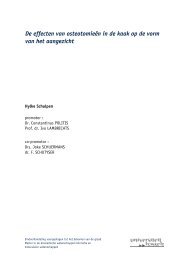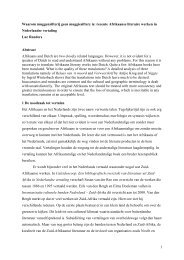Planning Problems in Intermodal Freight Transport ...
Planning Problems in Intermodal Freight Transport ...
Planning Problems in Intermodal Freight Transport ...
You also want an ePaper? Increase the reach of your titles
YUMPU automatically turns print PDFs into web optimized ePapers that Google loves.
<strong>in</strong>novative <strong>in</strong>termodal term<strong>in</strong>al concept (Bontekon<strong>in</strong>g and Kreutzberger [15]), which can<br />
replace shunt<strong>in</strong>g yards.<br />
Vis [16] discusses the strategic decision of choos<strong>in</strong>g the type of material handl<strong>in</strong>g<br />
equipment for storage and retrieval of conta<strong>in</strong>ers <strong>in</strong> and from the yard at sea term<strong>in</strong>als.<br />
Simulation is used to compare the use of manned straddle carriers with automated stack<strong>in</strong>g<br />
cranes. The total travel time required to handle a fixed number of requests serves as<br />
performance measure. A sensitivity analysis of the <strong>in</strong>put parameters is executed <strong>in</strong> order to<br />
formulate advice on the choice for a certa<strong>in</strong> type of material handl<strong>in</strong>g equipment <strong>in</strong> relation<br />
with the layout of the stack.<br />
3.3 Network Operator<br />
At a strategic decision level a network operator has to plan the <strong>in</strong>frastructure of the<br />
<strong>in</strong>termodal network. This implies decisions regard<strong>in</strong>g <strong>in</strong>vestments <strong>in</strong> l<strong>in</strong>ks and nodes.<br />
Network models have been proposed by various authors. Cra<strong>in</strong>ic et al. [17] extend uni-modal<br />
network models by add<strong>in</strong>g l<strong>in</strong>ks connect<strong>in</strong>g the various modes <strong>in</strong> order to derive an<br />
<strong>in</strong>termodal network model. The development of geographic <strong>in</strong>formation system (GIS)<br />
technology yields new opportunities for the modell<strong>in</strong>g of large multi-modal freight networks<br />
as Southworth and Peterson [18] show. Loureiro [19] presents a multi-commodity multi-<br />
modal network model to be used as a plann<strong>in</strong>g tool for determ<strong>in</strong><strong>in</strong>g <strong>in</strong>vestment priorities for<br />
<strong>in</strong>tercity freight networks. The ma<strong>in</strong> component of the model <strong>in</strong>corporates a non-l<strong>in</strong>ear bi-<br />
level multi-modal network design formulation. Its aim is to m<strong>in</strong>imise the transportation costs<br />
<strong>in</strong>curred by shippers and the environmental impacts caused by the use of less efficient modes<br />
of transportation for mov<strong>in</strong>g freight. Investment options to be considered by the model may









